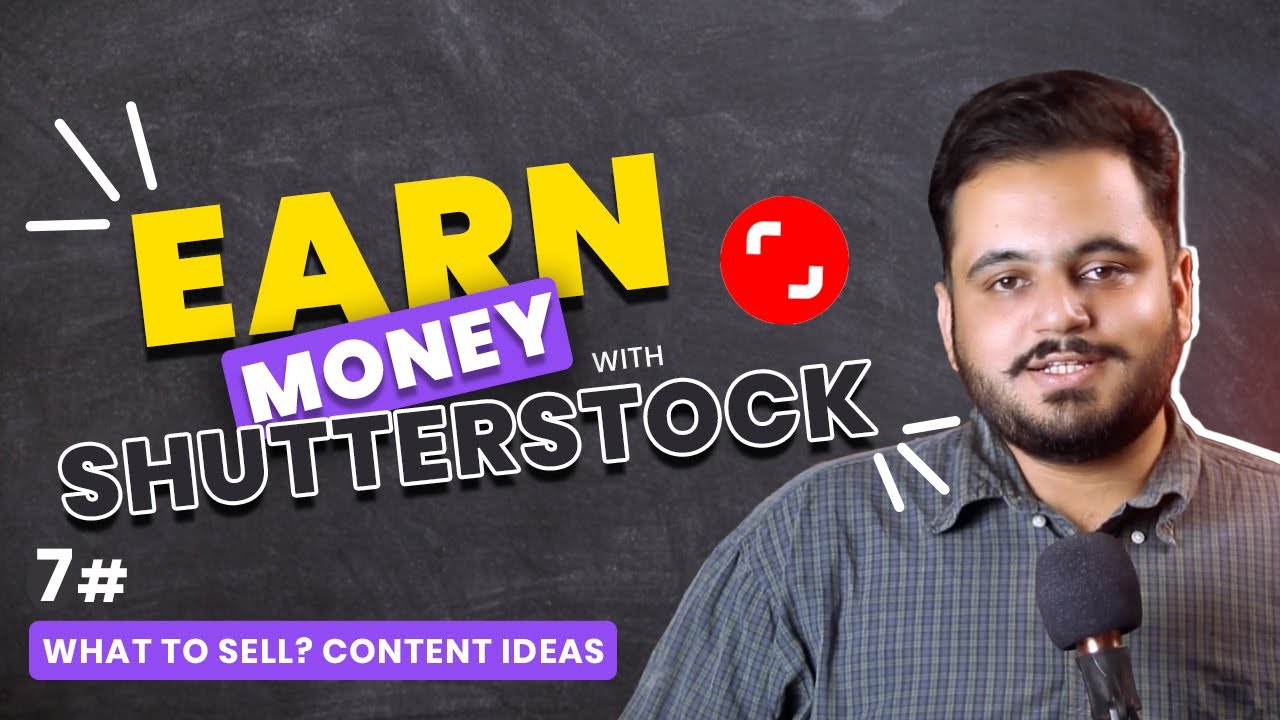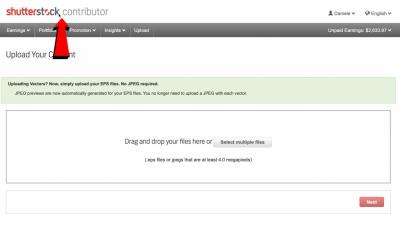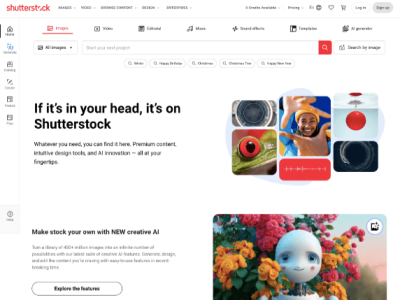Thinking about turning your photos, illustrations, or videos into a source of income? Shutterstock is one of the biggest platforms out there for stock content, connecting artists with millions of buyers worldwide. As a contributor, you get the chance to showcase your work to a global audience, earn royalties, and grow your portfolio. It’s a fantastic way to monetize your creativity, whether you’re a hobbyist or a professional. But how exactly does Shutterstock work for contributors? Let’s dive into what you need to know to get started and make the most of this popular platform.
How to Become a Shutterstock Contributor
Getting started as a Shutterstock contributor is pretty straightforward, but there are some important steps to follow to ensure you’re on the right path. Here’s a step-by-step guide to help you begin your journey:
- Create an Account: Head over to the Shutterstock Contributor website and sign up. You’ll need to provide basic information like your name, email, and create a password. Once registered, you can start submitting your work.
- Review the Submission Guidelines: Before uploading, it’s essential to understand Shutterstock’s content standards. They have specific rules about image quality, originality, and metadata. Reading these guidelines helps prevent rejections and speeds up the approval process.
- Prepare Your Content: Make sure your files meet the technical requirements. For images, this typically means high-resolution JPEGs with a minimum of 4 MP, properly exposed and in focus. For videos, ensure they are in the correct format and resolution. Add relevant keywords and descriptions to make your content discoverable.
- Upload Your Content: Use the contributor dashboard to upload your files. During upload, you’ll need to add titles, tags, and categories. Be descriptive and precise—good metadata improves your chances of sales.
- Submit for Review: Once everything’s uploaded and tagged, submit your content for review. Shutterstock’s review team will assess whether your files meet their standards, which usually takes a few days.
- Get Approved and Start Earning: When your content is approved, it goes live on the platform. From there, buyers can purchase your files, and you’ll earn royalties based on your earnings tier and the type of license sold.
Becoming a Shutterstock contributor is a rewarding process that hinges on quality and consistency. Keep uploading fresh content, follow the guidelines, and engage with the community to build your portfolio and income stream. Remember, patience is key—success doesn’t happen overnight, but with dedication, you can turn your creative work into a steady revenue source.
Uploading and Submitting Your Photos and Videos
Alright, so you’ve got your stunning photos and engaging videos ready to go — now what? Uploading and submitting your work to Shutterstock is a straightforward process, but there are a few tips and best practices to keep in mind to make sure everything goes smoothly.
First off, you’ll need to log into your Contributor account. Once you’re in, head over to the dashboard and look for the “Upload” button. Shutterstock allows you to upload multiple files at once, which is super handy if you have a batch of images or videos.
Here are some quick steps to guide you through uploading:
- Select Your Files: Choose the photos or videos you want to submit. Make sure they meet Shutterstock’s technical requirements (more on that in a moment).
- Add Metadata: Fill in the details for each file — titles, descriptions, keywords, and categories. This is super important because it helps buyers find your work. Be descriptive and specific with your keywords; think about what someone would type in if they were searching for your image.
- Review: Double-check all the information you’ve entered and ensure your files are high quality.
- Submit for Review: Hit the submit button, and your files will go into Shutterstock’s review queue.
When it comes to file formats, Shutterstock prefers high-resolution images in JPEG format with a minimum of 4 MP (megapixels), and videos should be in formats like MOV or MP4 with good quality and clarity. Keep your videos steady, well-lit, and free from distracting background noise for the best chances of acceptance.
Pro tip: Before uploading, give your files a final check for any artifacts, watermarks, or watermarks. Shutterstock is pretty strict about only accepting original, clean content.
Once you’ve uploaded and submitted your work, the platform will handle the rest. You can check the status of your submissions from your dashboard — whether they’re under review, approved, or rejected. And don’t worry if some get rejected; use the feedback to improve, and try again with other files!
Understanding Shutterstock’s Review and Approval Process
So, you’ve uploaded your stunning photos and videos — now, what’s next? Welcome to the review and approval process, which is a crucial step in getting your content live on Shutterstock. It might seem a bit daunting at first, but understanding how it works can help you navigate it smoothly and improve your chances of acceptance.
Once your files are submitted, they enter Shutterstock’s review queue. The review team, which consists of experienced content moderators, carefully examines each file based on several key criteria:
- Quality: Is your photo or video sharp, well-exposed, and free from noise or artifacts? Shutterstock values high-resolution, professional-quality content.
- Technical Compliance: Does your file meet the technical specifications? For images, this includes correct color profiles, no watermarks, and appropriate dimensions. For videos, proper formatting, no corruption, and good audio are essential.
- Content Originality: Is your work original and unique? Shutterstock aims to prevent duplicate or heavily similar content.
- Model and Property Releases: If your content features recognizable people or private property, appropriate releases are required. Without these, your content may be rejected or require additional documentation.
- Adherence to Content Guidelines: Your content should comply with Shutterstock’s content policies — avoiding prohibited subjects, offensive material, or copyright infringements.
Typically, the review process takes anywhere from a few hours up to several days, depending on the volume of submissions and the complexity of your files. If your content is approved, it’ll go live on the platform, and you’ll earn royalties whenever it’s downloaded. If it’s rejected, Shutterstock will usually provide feedback or reasons for the rejection, giving you a chance to learn and improve.
A few tips to speed up your approval process:
- Ensure your files are high quality and follow technical specs.
- Use relevant, well-researched keywords and accurate descriptions.
- Include model or property releases when necessary.
- Avoid submitting images or videos with watermarks, logos, or copyrighted elements.
Remember, patience is key. The review process is there to maintain Shutterstock’s high standards and ensure buyers get the best quality content. Keep honing your skills, and over time, your acceptance rate will improve as you understand exactly what the reviewers are looking for.
How Shutterstock’s Revenue Sharing and Payment System Works
If you’re diving into the world of Shutterstock as a contributor, one of the first things you’ll want to understand is how you actually get paid. Shutterstock’s revenue sharing and payment system can seem a bit complex at first, but once you get the hang of it, it’s straightforward and transparent.
So, let’s break it down. When someone downloads one of your images, video, or music tracks, you earn a certain percentage of the sale price. This percentage is called your “Royalty Rate.” Shutterstock offers different royalty rates depending on your exclusivity status and your total lifetime earnings.
Royalty Rates and Earnings
- Standard Contributors: Usually earn around 20-30% per sale.
- Exclusive Contributors: Can earn up to 30-40% per sale because they agree to sell only through Shutterstock.
In addition to the percentage, your actual earnings per download depend on the type of license purchased. Shutterstock offers two main types:
| License Type | Revenue Share | Description |
|---|---|---|
| Standard License | Lower royalty rate | Suits most common uses like websites, blogs, or presentations. |
| Enhanced License | Higher royalty rate | For larger-scale uses like merchandise or advertising campaigns. |
Shutterstock calculates your earnings automatically, based on these factors, and keeps track of your total earnings in your contributor dashboard. You can view your earnings history, see upcoming payments, and analyze which images or videos are performing best.
Payment Schedule and Thresholds
Shutterstock pays contributors via PayPal or Skrill once your earnings reach a minimum threshold, typically $35. Payments are made monthly, usually around the 15th of each month, for earnings accumulated in the previous month.
It’s good to note that there are no hidden fees or deductions beyond the agreed-upon royalty share. The platform is designed to be transparent, so you always know exactly how much you’re earning per download and when you’ll receive your money.
Additional Tips
- Keep an eye on your dashboard: Regularly check your earnings and sales reports.
- Understand licensing: The type of license purchased affects your earnings.
- Exclusivity bonus: If you choose to be exclusive, you might unlock higher royalty rates.
Understanding the payout system helps you set realistic goals and optimize your contributions to maximize your earnings. Now, let’s look at some practical tips to boost your income on Shutterstock!
Tips for Increasing Your Earnings on Shutterstock
Looking to make more money on Shutterstock? You’re in the right place. While the platform offers a steady stream of income, a few strategic moves can significantly boost your earnings. Here are some tried-and-true tips to help you grow your portfolio’s performance and your bottom line.
1. Focus on Quality Over Quantity
It might be tempting to upload lots of images quickly, but quality always wins. High-quality, well-composed images tend to attract more buyers and get downloaded more often. Take the time to edit, crop, and ensure your images are sharp and well-lit.
2. Cover Trending and Evergreen Topics
Keep an eye on current trends and evergreen themes that never go out of style. Think of topics like business, technology, health, or celebrations. Content in these areas tends to be in high demand year-round. Use tools like Google Trends or Shutterstock’s own popular searches to guide your content creation.
3. Use Relevant Keywords Strategically
Keywords are your best friends when it comes to discoverability. Use descriptive, specific keywords that match what buyers are searching for. Don’t overstuff, but make sure your keywords accurately reflect the content of your upload. Check out successful contributors’ keywords for inspiration.
4. Diversify Your Portfolio
Don’t put all your eggs in one basket. Upload different types of content—photos, vectors, illustrations, videos, and music tracks. This diversification increases your chances of making sales across various categories and licenses.
5. Optimize Your Content for Searchability
Beyond keywords, include clear titles and detailed descriptions. Use natural language that potential buyers might use when searching. The easier your content is to find, the more downloads you’ll get.
6. Regularly Update and Refresh Your Portfolio
Keep uploading new content regularly. Shutterstock favors active contributors, and fresh uploads can boost your visibility on the platform. Plus, adding new material keeps your portfolio interesting and relevant to buyers.
7. Promote Your Work Outside Shutterstock
Share your portfolio on social media, your website, or professional networks. While Shutterstock traffic is significant, external promotion can bring in new buyers and increase downloads.
8. Participate in Shutterstock’s Contributor Community
Engage with other contributors, join forums, or participate in contests. Networking can give you insights into what sells best and help you stay motivated and inspired.
By applying these tips consistently, you’ll not only increase your earnings but also build a stronger, more recognizable portfolio. Remember, patience and persistence are key—success on Shutterstock is a marathon, not a sprint. Keep creating, optimizing, and staying engaged, and you’ll see your income grow over time.
Common Challenges Faced by Shutterstock Contributors and How to Overcome Them
Becoming a successful Shutterstock contributor is an exciting journey, but it’s not without its hurdles. Many contributors encounter similar challenges along the way. Knowing what these are—and how to tackle them—can make all the difference in your success story.
One of the most common issues is standing out in a crowded marketplace. With millions of images uploaded, getting your work noticed can feel overwhelming. To overcome this, focus on creating high-quality, unique content that fills gaps in the marketplace. Research trending topics and popular categories, then tailor your portfolio to meet those demands.
Another challenge is understanding licensing and copyright rules. Shutterstock has strict guidelines, and a mistake here can lead to rejected submissions or even account issues. The key is to thoroughly read and understand their contributor guidelines. Always ensure you have the proper rights for all elements in your images, especially if they contain recognizable people or copyrighted objects.
Dealing with rejection is also part of the process. Not every image will be accepted, and that can be discouraging. Instead of taking it personally, view rejection as a learning opportunity. Review Shutterstock’s feedback, improve your images based on their comments, and keep experimenting with new techniques and styles.
Maintaining a consistent upload schedule can be tricky, especially if you’re balancing other commitments. However, regular uploads help keep your portfolio active and improve your chances of earning more. Set achievable goals—perhaps a few images each week—and stick to a routine that works for you.
Finally, staying motivated when sales are slow can be tough. Remember, success on Shutterstock often takes time. Keep creating, refining, and uploading. Engage with other contributors in forums or social media groups for support and advice. Persistence and continuous learning are your best tools to overcome these common challenges.
Conclusion and Final Tips for Success as a Shutterstock Contributor
Embarking on your journey as a Shutterstock contributor can be both rewarding and demanding. While the road has its challenges, with a strategic approach and a bit of perseverance, you can build a thriving portfolio and generate a steady income stream.
Here are some final tips to help you succeed:
- Focus on Quality Over Quantity: Upload high-resolution, well-composed images that meet Shutterstock’s standards. A few standout images are better than numerous mediocre ones.
- Stay Consistent: Regularly upload new content to keep your portfolio active and increase your visibility in search results.
- Research Trends: Keep an eye on trending topics and popular categories. This can guide your creation process and help your images sell faster.
- Learn from Feedback: Pay attention to Shutterstock’s review comments. Use them as a learning tool to improve your future submissions.
- Protect Your Work: Always ensure you have the proper model releases and property releases when necessary. This helps prevent rejection and legal issues down the line.
- Engage with the Community: Join forums and social media groups for Shutterstock contributors. Sharing tips, experiences, and encouragement can boost your motivation and knowledge.
Remember, success doesn’t happen overnight. Patience, persistence, and continuous improvement are your best allies. Keep experimenting, stay inspired, and enjoy the creative process. With time and effort, you’ll see your work gain recognition and start generating those valuable sales. Happy contributing!



